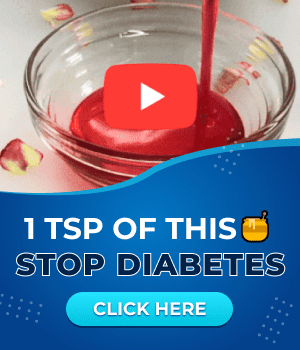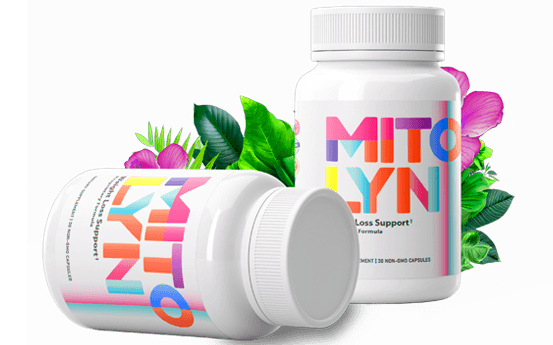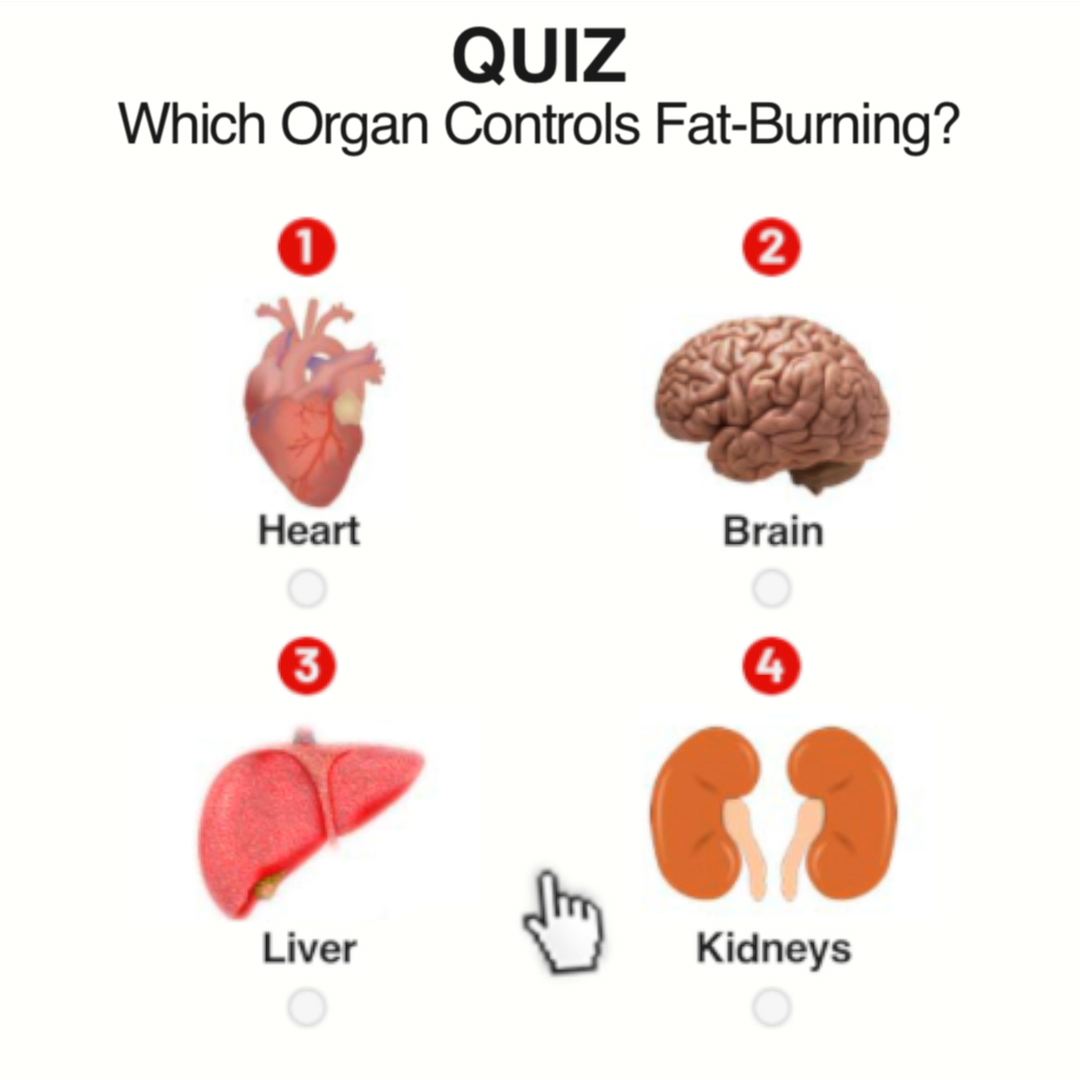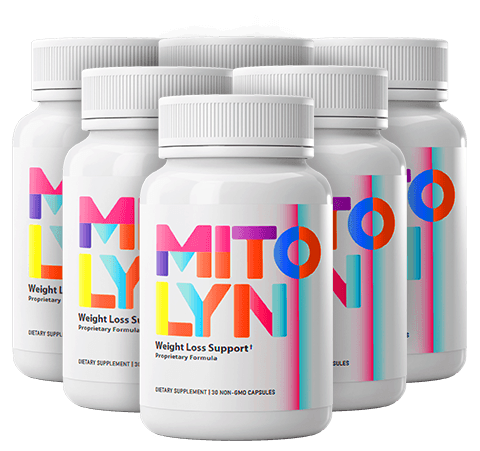
Did you know nearly one in five adults in the U.S. faces mental health challenges? Yet, many still hide their struggles. This month, as we celebrate Mental Health Awareness, let’s rethink how sharing your story could change not just your life, but someone else’s too.
Imagine a world where talking about mental wellbeing feels as natural as discussing your diet or workout routine. That’s the goal of mental health awareness—a movement turning stigma into support. This article is your guide to understanding how small steps, like daily mindfulness or reaching out to a friend, can build a stronger emotional health foundation.
Here’s why this matters: when you prioritize mental health insights, you’re not just fixing problems—you’re nurturing resilience. From setting SMART goals to using tools like journaling, every choice counts. And remember, you’re never alone: resources like NAMI or the Suicide Prevention Lifeline offer real help when you need it most.
Key Takeaways
- 1 in 5 adults in the U.S. experience mental health conditions, making awareness critical.
- Sharing personal stories reduces stigma and builds community support.
- SMART goals and mindfulness practices improve mental wellbeing daily.
- Free helplines like NAMI and SAMHSA connect people to vital resources.
- Mental health awareness empowers you to seek help and help others.
The Importance of Mental Health Awareness in Today’s World
Your daily mental health is more than just feeling happy. It’s about how you deal with stress, connect with others, and even do your job. The importance of mental health is huge. Ignoring it can quietly mess up your life, especially with issues like anxiety or depression.
- 19% of U.S. adults live with mental illness.
- 48 million adults face anxiety disorders annually.
- Over 21 million adults experience major depression.
These numbers show why mental wellbeing recognition is key. Companies like NAMI and Mental Health America offer free screenings. This shows how schools and workplaces are starting to care about mental health. But, stigma still stops many from seeking help: only half of those affected get treatment.
Think of your daily mental health as a daily check-in. Small steps, like mindfulness or talking to a therapist, can change your mind. Awareness is not just about dealing with crises—it’s about preventing them.
What Mental Health Awareness Really Means
Mental health awareness is more than knowing about disorders. It’s about understanding mental health as a wide range that affects us all. It’s about knowing how to help ourselves and others, no matter our situation.

Real mental health education shows that our mental health comes from biology, environment, and life events. Safe homes, education, and community ties are key, as the CDC’s research shows. When 1 in 5 adults deal with mental illness each year, awareness means seeing their struggles without judgment.
- Learning to spot early signs of distress helps break the cycle of mental health stigma.
- Knowing resources like telehealth connects people to care, reducing barriers to treatment.
- Understanding that mental health fluctuates helps create supportive environments at home, school, and work.
“By opening up about our mental health journey, we break down barriers and reduce the stigma surrounding mental health issues.”
Mental health awareness also means taking action. SAMHSA says half of mental health issues start by age 14, so early education is crucial. Schools and workplaces can promote mental wellness awareness through open talks and training. Even small actions, like checking on a friend, can help a lot.
Every talk, whether in school or at home, builds a culture where seeking help is seen as a strength. This is how awareness turns into action.
Understanding the Mind-Body Connection
When you take care of your body, your mind gets better too. The mind-body connection shows how your body habits affect your feelings. Exercise, diet, and sleep are not just for fitness. They help balance your physical and mental health.

How Physical Health Impacts Your Mental State
Your daily choices affect your mood and energy. For example:
- Exercise boosts serotonin, lifting your spirits.
- Healthy eating fuels your brain, reducing anxiety.
- Sleep repairs your body and sharpens focus.
Poor physical habits? They can make stress worse, leading to fatigue and low mood.
The Science Behind Stress and Your Body
Stress triggers a stress response, releasing cortisol. This helps in emergencies but harms your heart, gut, and immune system over time. Chronic stress even shrinks brain areas tied to memory. Studies show 1 in 5 Americans face mental health struggles linked to these effects.
Building Resilience Through Holistic Health Practices
Holistic health practices build mental resilience. Try:
| Practice | Benefits |
|---|---|
| Mindfulness | Reduces stress, improves focus |
| Yoga | Combines movement and breathing for calm |
| Healthy Eating | Nutrients support brain health |
Reflective practices like journaling help you understand your emotions and respond better to challenges.
Incorporate these steps daily, and you’ll notice improvements in how you handle stress and stay mentally strong.
Recognizing the Signs: When Your Mental Health Needs Attention
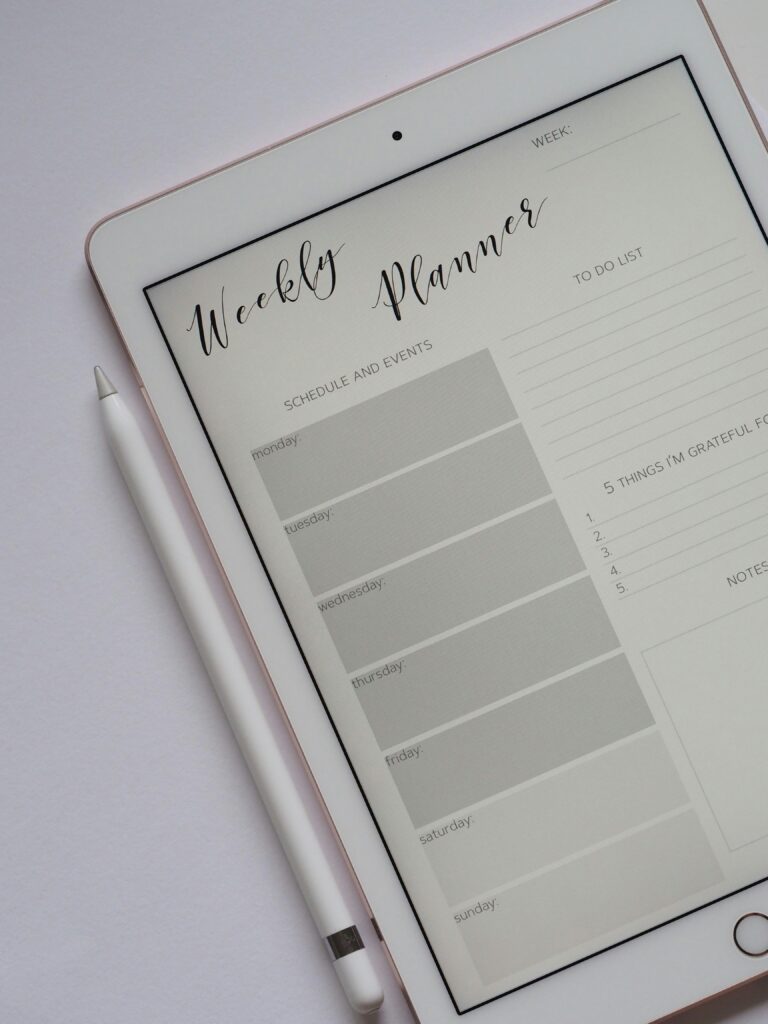
Over 44 million Americans face mental health challenges each year. Early mental health warning signs like changes in sleep, appetite, or mood can signal when to act. Recognizing these mental health symptoms early improves outcomes—studies show 50% of mental illnesses begin by age 14. Here’s how to spot red flags and take action:
Common Warning Signs You Shouldn’t Ignore
- Extreme shifts in sleep (too much or too little)
- Loss of interest in hobbies or socializing
- Unexplained aches, headaches, or digestive issues
- Irritability or aggression lasting weeks
- Difficulty concentrating or making decisions
Distinguishing Temporary Stress from Deeper Issues
| Temporary Struggle | Deeper Issue |
|---|---|
| Lasts days to weeks | Persists months or longer |
| Affects some daily tasks | Disrupts most areas of life |
| Improves with self-care | Needs professional support |
Self-Assessment Tools You Can Use Today
Take charge with these steps:
- Use free screening tools like the PHQ-9 for depression or GAD-7 for anxiety.
- Track patterns in mood, sleep, and energy levels over two weeks.
- Discuss results with a trusted professional if concerns arise.
Remember, recognizing mental health issues early can prevent long-term challenges. Small steps today lead to bigger strides in wellbeing.
Practical Steps to Improve Your Mental Health Every Day
“Mindfulness is like a muscle—it grows stronger with consistent practice.” — National Institute of Mental Health
Small changes can make a big difference. Start with daily mental health tips that fit into your daily life. Take one minute to breathe deeply before starting your day. Writing a few things you’re grateful for before bed can change your mindset.
These simple actions help build strong mental health habits. They make you more resilient over time.

- Practice mental health practices like mindful breathing or stretching during work breaks.
- Schedule a 10-minute walk outside daily to boost mood and energy.
- Try a gratitude journal: write three things you’re thankful for each evening.
Try weekly mental health habits like:
- Join a hobby group or volunteer to strengthen social bonds.
- Set aside time for creative activities like drawing or cooking.
- Review your sleep schedule—aim for 7-9 hours to support improving mental wellbeing.
Look into tools from Mental Health America or the American Academy of Family Physicians for help. Remember, it’s about progress, not being perfect. Find what makes you happy and celebrate each small victory.
The Power of Connection: Building a Support Network
Starting a mental health support network means finding places where you feel heard. This can be through local groups, online forums, or hobbies. Community support turns challenges into shared victories. Studies show a 30% lower risk of early death with strong social bonds.
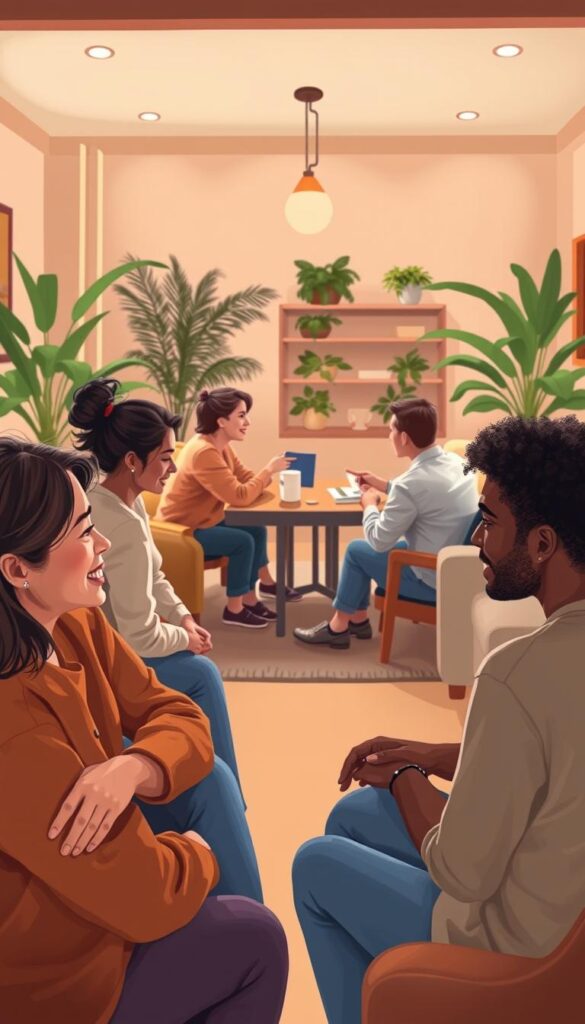
Finding Your Tribe: Communities That Foster Mental Wellbeing
Look for groups that match your needs:
- Support groups: Join places like Oaks Integrated Care’s programs in New Jersey for help.
- Volunteer roles: Helping others builds empathy and purpose.
- Online forums: Sites like 7 Cups offer anonymous support.
“When we share with others, we often find that they have gone through similar struggles, fostering a sense of connection and understanding.”
Having Difficult Conversations About Your Mental Health
Talking about mental health can be easy. Here’s how to start:
- Start small: Say you feel overwhelmed instead of saying you’re sick.
- Choose trusted listeners: Pick someone who always listens well.
- Use “I” statements: Saying “I feel anxious when…” helps avoid blame.
| Topic | Impact of Strong Social Support |
|---|---|
| Mental Health Outcomes | 40% reduction in depression symptoms (WHO, 2023) |
| Physical Health | Lower risk of heart disease and diabetes |
| Community Stigma | Reduced by 30% in engaged communities |
Supporting Loved Ones Through Their Mental Health Journey
When supporting mental health, focus on empathy. Here are some tips:
- Listen without judgment—let them lead the conversation.
- Encourage professional help without pressure.
- Create shared activities to rebuild connection.
Your role is to be a steady friend. Small actions like checking in weekly help both of you.
Mental Health Awareness in Different Life Stages
Your mental health changes as you grow. Let’s look at how to care for life stage mental health at important times. This includes from when you’re young to when you retire.
Childhood mental health is crucial for future strength. The early years are vital for learning emotional skills. Watch for signs like pulling back or acting out in kids. Childhood mental health programs, like MHA’s free screenings, help find problems early.
Schools and families can teach kids how to handle bullying or school stress.
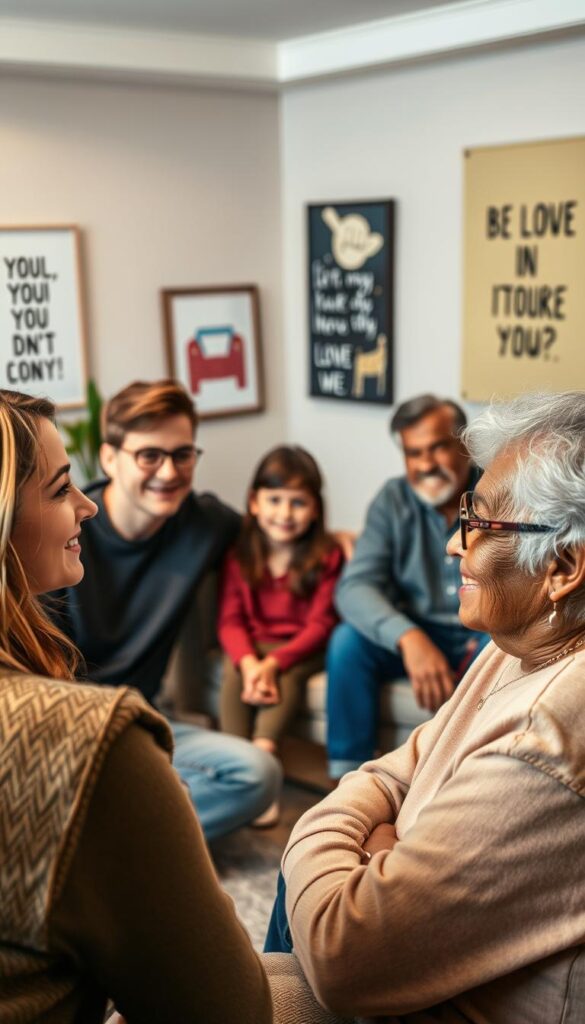
At work, workplace mental health affects everyone. Did you know 1 in 5 U.S. workers say their mental health is fair or poor? This can lead to lost productivity. Companies that focus on wellness have teams that are three times more engaged.
Here’s how you can help:
- Set clear boundaries between work and rest.
- Talk about stress with your manager.
- Use your employer’s EAP programs.
Seniors face special challenges like feeling lonely or grieving. Senior mental health care aims to keep them connected through community programs or hobbies. Retirement, chronic illness, and loss need special support. SAMHSA’s Mental Health Action Day encourages us to take action, not just watch.
Breaking the Stigma: Becoming an Advocate for Mental Health Awareness
Everyday actions can chip away at mental health stigma. Advocacy starts with small, intentional steps. By changing how you speak or listen, you help create a culture where seeking help is seen as strength, not weakness.
- Use person-first language: Say “person living with anxiety” instead of “an anxious person.”
- Correct stigmatizing comments when you hear them. A simple “Actually, depression isn’t just sadness” can spark mental health conversations.
- Share your story if it feels right. Public figures like Demi Lovato have shown how personal narratives reduce shame and encourage others to speak up.
“Your story might inspire someone who is hesitant to seek help, showing them that feeling understood can make all the difference.”
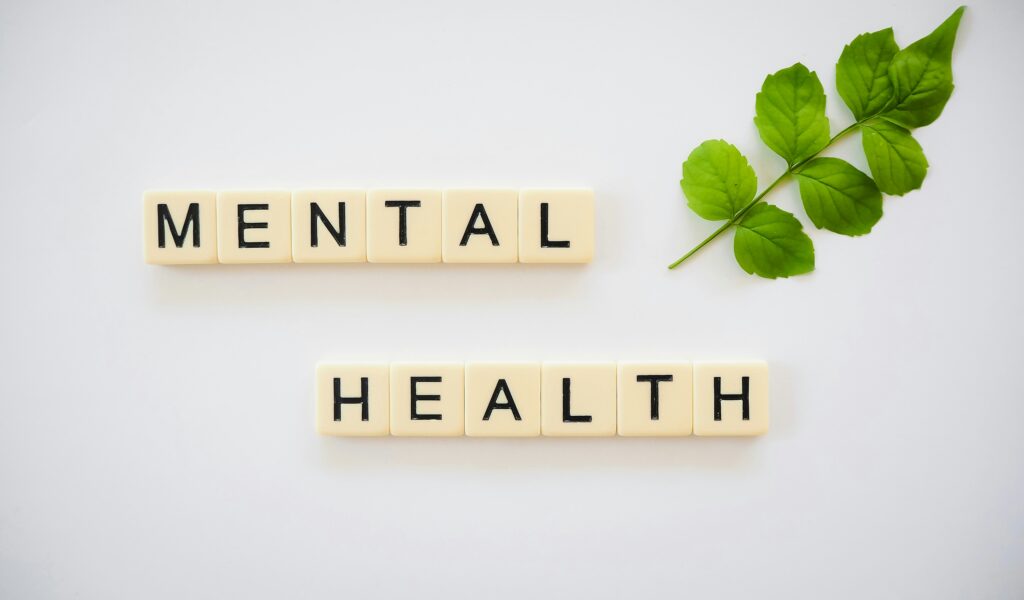
Community efforts like Mental Health First Aid train individuals to support others. Policies like workplace mental health days reflect broader mental health advocacy. Even small acts—like listening without judgment—can shift norms. When you speak up, you join a movement that turns awareness into action.
Advocacy is a ripple: your voice strengthens networks of support. Whether online, at work, or in casual chats, your words can help others feel seen. Together, these steps build a world where mental health stigma fades, replaced by empathy and understanding.
Digital Wellbeing: Managing Your Mental Health in the Age of Technology

Managing social media mental health begins with small choices. Teens who spend over 3 hours daily on social media face higher risks of anxiety or depression. Setting time limits and taking mindful breaks can help. Try these steps:
- Set daily social media limits using phone screen time trackers
- Enable “Do Not Disturb” modes during study or sleep times
- Curate feeds by following uplifting accounts only
Smartphone apps offer tools for digital wellbeing. Apps like Calm (meditation), Woebot (AI therapy), and Daylio (mood tracking) provide structured support. Always check app reviews and consult professionals before use.
| Technology Benefits | Potential Risks |
|---|---|
| 24/7 access to therapy platforms | Data privacy concerns |
| Real-time crisis hotlines via apps | Overstimulation from constant notifications |
| Mood tracking for behavioral insights | Comparison anxiety from curated posts |
The BRIGHTEN study shows how apps can deliver treatments while collecting vital data. But remember, no app replaces human connection. Use tech tools with in-person interactions. For every minute online, spend 30 seconds in mindful breathing exercises.
Protect your mental space by:
– Blocking graphic content alerts
– Scheduling weekly “digital detox” hours
– Fact-checking stressful online claims
Maintaining technology and mental health balance requires intention. Choose apps wisely, set boundaries, and prioritize real-world connections. This builds a healthier digital ecosystem.
Professional Help: When and How to Seek It
Feeling stuck or overwhelmed? Seeking mental health help is a brave step toward healing. If you’re unsure if it’s time to reach out or how to start, here’s what you need to know.
- Feelings of hopelessness lasting weeks
- Difficulty handling daily tasks
- Thoughts of self-harm or suicide
When choosing a mental health professional, consider their expertise. Here’s a quick guide:
| Type | Specialty | Best For |
|---|---|---|
| Therapist | Talk therapy | Managing stress, grief, or relationship issues |
| Psychologist | Assessments, long-term therapy | Complex conditions or diagnosis |
| Psychiatrist | Medication management | Combining therapy with prescriptions |

Over 80% of people treated for depression improve with the right mental health treatment.
Ready to find support? Here’s how to start:
- Check your insurance portal for therapy options in your network.
- Use SAMHSA’s Behavioral Health Treatment Locator or call 800-662-HELP.
- Try free crisis support via 988 or text MHA to 741741.
Cost concerns? Public community clinics and sliding-scale providers offer affordable care. Ask your employer’s EAP for referrals. Always ask questions like: “How do you approach treatment?” or “What are my payment options?”
Remember: reaching out is a strength. Every step toward finding a mental health professional brings you closer to feeling better.
Conclusion: Your Journey Toward Better Mental Health Starts Today
Your mental health journey is unique, but you’re never alone. Every day is a chance to focus on your well-being. Start with small steps like daily exercise or finding mental health resources.
Begin with actions that feel easy, like journaling or talking to a friend. EasyLlama’s courses can also help. These steps are the start of your mental health journey.
Remember, mental health disorders affect many people, but help is available. EasyLlama’s programs have helped over 8,000 businesses. They offer tools to face challenges and build strong communities.
Share your story and advocate for mental health. Use EasyLlama’s courses to learn and connect. Every step you take is important, even if it’s not always easy.
Explore what works for you, like professional help or simple routines. Your journey is important, and small steps today can make a big difference. Together, we can make mental health awareness a shared goal.
FAQ
What is mental health awareness?
Mental health awareness means understanding it’s a spectrum. It affects everyone. It’s about recognizing signs, treatments, and creating supportive spaces.
Why is mental health important for my daily life?
Mental health affects your physical health, energy, and relationships. It’s key for your overall wellbeing.
How can I recognize when I might need mental health support?
Look for changes in sleep, mood, and social withdrawal. These signs show you might need help.
What are some practical steps I can take to improve my mental health daily?
Try mindfulness, exercise, and journaling. Building strong social connections also helps your mental health.
How can I talk to someone about my mental health?
Be open and honest with friends and family. Use clear language and listen well to support each other.
What role do social connections play in my mental health?
Good social connections help you face mental health issues. They support recovery and are very important.
How does mental health awareness change across different life stages?
Mental health needs change with age. Children, adults, and seniors face different challenges. Each needs a special approach.
What is the impact of technology on my mental health?
Technology has both good and bad sides. Set limits on social media and use helpful apps. This keeps your digital life healthy.
When should I seek professional help for my mental health?
If your mental health issues last or affect your daily life, get help. This shows you’re strong and aware.
How can I contribute to breaking the stigma around mental health?
Fight stigma by spotting harmful words and sharing your story. Create safe spaces for mental health talks. This builds understanding and kindness.





